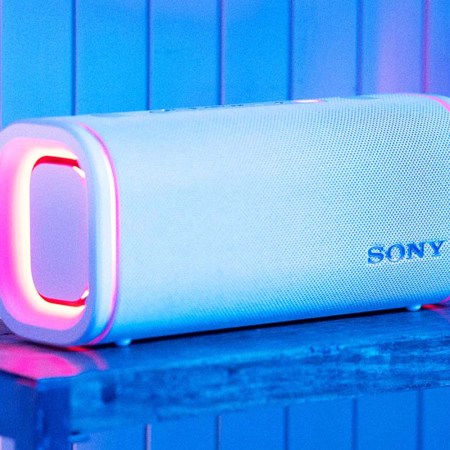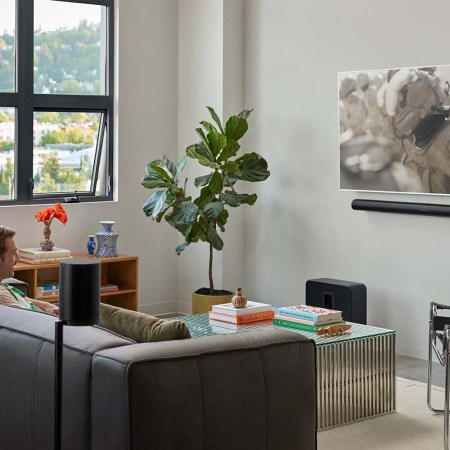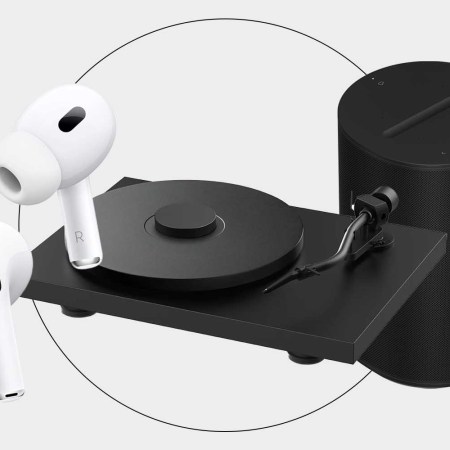Voice control is the future, they say. According to one recent report, voice-activated smart speakers could reach over half of U.S. households within five years. Admittedly, most of those voice controls will be conducted through smartphones — and, most likely, the ubiquitous smart speakers and peripherals from Amazon (Echo, Echo Dot, etc.).
But what Sonos is doing is actually smart. In lieu of adding another device to your house, they’re taking their core product (great speakers) and infusing ‘em with the brains of Amazon’s Alexa. So, great sound and a voice assistant in one compact package.
So … Does it work?
We tested out the new Sonos One just before the speaker’s release this fall to find out. After a few weeks of use and a delay while Spotify was integrated, we have a verdict: The future sounds promising. But it may not be here. Yet.
How it works
Dig your current Sonos speakers? The Sonos One is pretty much a Play:1 with the addition of Alexa voice control and capacitive touch controls (volume, next track, mute, LED status updates). It looks good/unobtrusive in any room (available in neutral black or white variations) and delivers great sound for such a tiny system — it’s certainly a step above other smart speakers like the Echo.
You can pair the One with other Sonos products and have your house ready to go quickly: connecting to our home wifi was easy, although we were just using one speaker (thans, New York apartment).
The speaker has two Class-D digital amplifiers, one mid-woofer and one tweeter. The interior six-mic array and an adaptive noise suppression algorithm supposedly help Alexa cut through the outside noise and process your verbal commands clearly. It worked perfectly (outside of one instance, see below) for me. My Australian girlfriend, however, had to exaggeratedly annunciate to get a response.
What we liked
Setup on our home WiFi and adding devices (like a smart light) was a snap. Everything sounded great, even in a big room with high ceilings: you can calibrate the sound via Sonos’s Trueplay system, which uses an app and your smartphone mic on to sonically measure the room and adjust acoustics.
If you have more than one Sonos, you’ll be able to play ‘em together or divide ‘em up into different groupings around the house. We saw this in action during a test run at a Sonos press preview, and it seemed to work fine.
What we didn’t like
The problems with the Sonos One begin and end with Alexa. And deciding to buy and use one of these speakers is going to depend on your personality. Learning to say very specific, multi-word requests and demands — which change with each “skill” — is something a casual user may not love.
Take music. It took a few weeks for Spotify integration to come into play — before then, voice command was limited to Amazon Music, iHeartRadio, TuneIn, SiriusXM and Pandora. When Spotify was ready, it did fine with starting up playlists (“Alexa, play New Release Radar playlist”) and general requests (“Alexa, play New Order”). Still, if you have more than one music service, more than one speaker or Spotify isn’t your default music service, you could be making long-winded commands like “Alexa, play (song name) by (artist) in the (room name) from Spotify.”
Woof.
While the company claims its voice-capture technology allows the speaker to hear commands over music, this was rarely the case. A few frustrated yells about volume (more successful when I stood next to the speaker) and I eventually gave up and used the app.
Now, there is a lot Alexa can’t do yet, but could do sometime in the near future. A good list of its shortcomings (music alarms, please!) is available here.
What you’ll use this for
Music, natch (if you’re picky, stick with the app over voice controls). Weather reports. Very general news (it’s called a Flash Report, and you set up what sources you want to hear — based off of ESPN’s reports on Sunday, your news is going to be a few minutes behind the real world). Bored days when you want to scroll through Alexa’s skills and fool around with a few games (Jeopardy) or uh, fart noises.
Controlling your smart home is solid, however: we had the Sonos connected to a Smart Life-enabled lamp in minutes. A simple command of “Alexa, turn off the living room light” has improved our lives and made us infinitely lazier.
Who is this for?
New Sonos owners who want to experience voice-control technology in its occasionally frustrating and limited infancy.
Who isn’t this for?
If you have an older Sonos, you can pair those speakers with an Echo or Echo Dot and pretty much get the same voice control. No need, for now, to replace what you have. Oh, and those with privacy concerns. Which is a big deal: your speaker is always on. And always listening.
What’s next?
Google Assistant and Apple AirPlay 2 support are coming in 2018. And some sort of smart home collaboration with IKEA in 2019.
This article appeared in an InsideHook newsletter. Sign up for free to get more on travel, wellness, style, drinking, and culture.
























